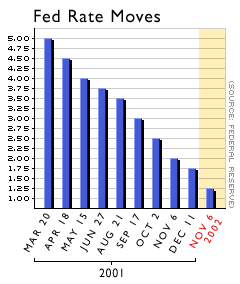NEW YORK (CNN/Money) -
Federal Reserve policy-makers left their target for a key short-term interest rate unchanged at a 40-year low Tuesday, and some economists believe the Fed's aggressive rate-cutting campaign may be over.
At its last policy meeting of the year, the central bank left its target for the federal funds rate, an overnight lending rate that banks use as the basis for their prime lending rates, at 1.25 percent.
The move -- or non-move -- was widely expected by economists, many of whom believe the Fed has done all it can do to help an economy still struggling to recover from last year's recession.

"I think the Fed is pretty much done for this economic cycle, unless some major catastrophe develops, such as a messy war in the Middle East or a housing bubble bursting," said Sung Won Sohn, chief economist at Wells Fargo Bank.
The Fed also kept the so-called "neutral bias" it adopted during its Nov. 6 meeting, when it also slashed interest rates by a half percentage point, but said the risks to the economy were balanced between a risk of inflation and a risk of further weakness.
But the Fed dropped the comments it made last month about "greater uncertainty ... inhibiting spending, production and employment." Instead, it referred only to the economy being in a "soft spot" and said it thought its current policy position would pull the economy through.
"The limited number of incoming economic indicators since the November [6th policy] meeting, taken together, are not inconsistent with the economy working its way through its current soft spot," the Fed said in its statement.
The Fed's decision had little impact on U.S. stock prices, which continued to trade higher. Treasury bond prices fell.
| Related stories
|

|
|
|
|
When it wants to jump-start the economy, the Fed cuts short-term interest rates to make borrowing cheaper and encourage consumer spending, which makes up more than two-thirds of the total economy. When it's concerned about inflation, the Fed raises rates to cut off the supply of money.
The Fed cut rates 11 times in 2001 to fight the effect of a recession that likely began in March 2001, terror attacks, falling stock prices and other woes.
Thanks in part to the Fed and to low mortgage rates that allowed many homeowners to cut their monthly mortgage payments, putting more money in their pockets every month, consumers kept spending.
But businesses, which overspent on new technology and production equipment in the late 1990s, were far more reluctant to spend. They were also reluctant to hire new workers, after cutting more than 1.8 million jobs during the recession.
The economy recovered early in 2002, and the Fed left rates alone, waiting to see if the recovery would take hold or fall apart.
But concerns about the possibility of a war in Iraq, along with falling stock prices and the inability of businesses to raise prices for their goods, contributed to business skepticism, which kept businesses from hiring and helped lead to what Fed Chairman Alan Greenspan called a "soft patch" in the recovery.
The weakness led the Fed to slash rates by a half-percentage point in November. But the Fed also shifted its "bias" from one of concern about further weakness to one of neutrality, a clear message to Wall Street that it had no interest in embarking on another rate-cutting campaign.
Instead, many economists are now looking to President Bush and Congress to come up with other ways to get the economy moving.
Bush lately has signaled his willingness to take on this task by purging his little-respected team of economic advisers and replacing them with new faces who might better be able to sell his economic plan to Congress and the rest of the country.
The atmosphere of turbulence created by the forced resignations last week of Treasury Secretary Paul O'Neill and chief White House economic adviser Lawrence Lindsey was all the more reason for the Fed not to make any unexpected moves Tuesday, many economists thought.
"After the fireworks we've seen coming out of Washington on Friday and Monday, I think the Fed would like to be the least bit of news this week," Diane Swonk, chief economist at Bank One, told CNNfn's Money Gang program.

|

